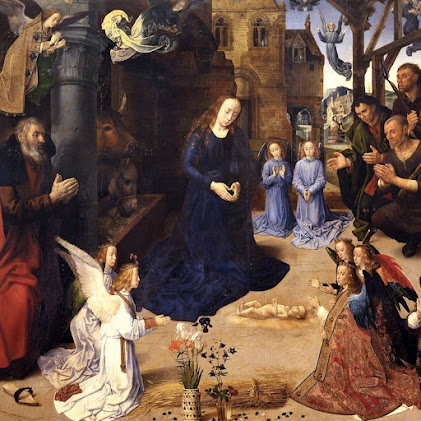The Nativity through Art: Advent Day Fifteen 15/12/24
Welcome to the third Sunday of Advent. Today, let's reflect together on sacred art and how it can guide our meditation on the Incarnation.
The Gospel of Luke provides one of the most detailed accounts of the Nativity:
And she gave birth to her firstborn son and wrapped him in swaddling cloths and laid him in a manger, because there was no place for them in the inn. (Luke 2:7)
Adoration of the Magi by Botticelli (1475)
This painting emphasises the recognition of Christ's divinity by worldly powers. The Magi's rich clothes and humble postures create a powerful contrast, symbolising how earthly authority bows before divine wisdom.
The Nativity by Federico Barocci (1597)
Notable for its use of light, this painting emphasises the divine light emanating from the Christ child. The dramatic illumination reflects the theological concept of Christ as the "light of the world."
Adoration of the Shepherds by Giorgione (1510)
This painting captures the humility of Christ's birth, showing how God chose to reveal himself first to simple shepherds. It reflects the Gospel message that divine truth is often revealed to the humble.
The Portinari Altarpiece by Hugo van der Goes (1475)
This painting emphasises both the humanity and divinity of Christ. The detailed still life elements carry rich symbolic meaning, whilst the contrast between the angels and humble shepherds illustrates divine glory meeting earthly simplicity.
Mystic Nativity by Botticelli (1500)
This painting combines apocalyptic imagery with the nativity scene. Angels dance in heaven whilst demons flee, representing the cosmic significance of Christ's birth.
The Nativity at Night by Geertgen tot Sint Jans (1490)
This painting also focuses on divine light emanating from the Christ child, illuminating the darkness - a powerful metaphor for Christ's role in human salvation.
All of these above artistic interpretations remind us God chose to enter our world not in grandeur, but in humble circumstances that anyone could relate to. Each artist brings their unique cultural perspective, helping us see this timeless story through different lenses.
As Fra Angelico, the blessed Dominican painter noted, "He who wishes to paint Christ's story must live with Christ", suggesting these artists weren't just creating beautiful images, but engaging in deep spiritual meditation through their work.
Making It Real: Practical Steps
Consider these ways to engage more deeply with sacred art:
- Set aside time today to contemplate one piece of the above Nativity art
- You could also research the historical context and symbolism
Today's Reflection
As you meditate on Nativity art, consider:
- What details in these artworks most capture your attention and why?
- How might different cultural interpretations of the Nativity deepen your understanding?
- What emotions do these sacred images stir in your heart?
Finding Your Own Path
Remember that each person connects with different aspects of sacred art. Some may be drawn to the technical mastery, others to the symbolic elements, and still others to the emotional impact. Allow yourself to be moved in whatever way speaks to your heart.
Prayer
Lord, open our eyes to see the beauty of Your incarnation as depicted through the ages by artists inspired by faith. Help us to discover You anew through their vision and devotion. Guide us to a deeper appreciation of how art can lead us closer to You. Amen.
Your Personal Invitation
Today, choose one piece of Nativity art from today that moves you deeply. Spend 15 minutes in quiet contemplation with it, allowing its details and meaning to speak to your heart. Consider keeping this image nearby throughout the Advent season as a focal point for prayer and reflection.
God bless,
Mel








